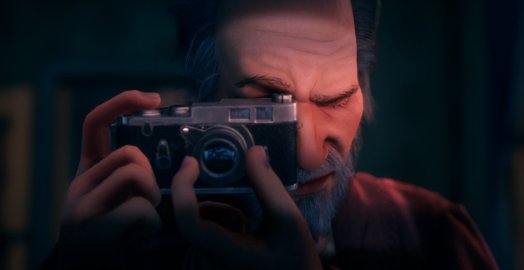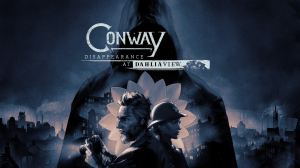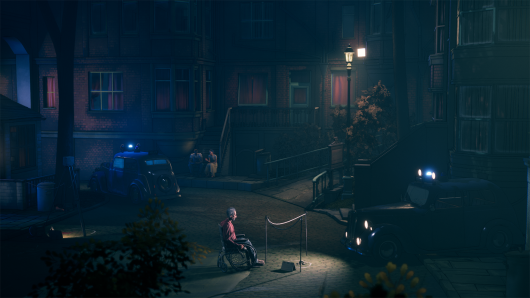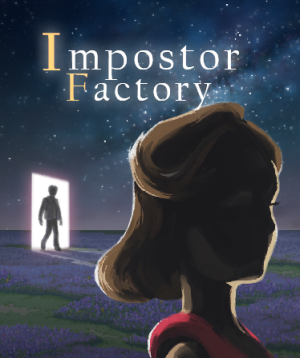Review for Conway: Disappearance at Dahlia View

We’ve probably all experienced plenty of disturbing things while playing adventures over the years. Whether investigating ritual murder, serial killings, or many other types of horrific events, the taking of virtual life may even have become fairly dull by this point. But as desensitized as we might be to the violence inflicted throughout games, I think most would agree there is one type of offense that still has the ability to cause a lump in our throats: crimes against children. Opening with a cinematic of a baby abducted from its crib in 1940 England, and set against the backdrop of the kidnapping of an innocent young girl 14 years later, the newest White Paper Games mystery Conway: Disappearance at Dahlia View is a flawed but engaging suspense adventure that will likely make any parent want to hug their kids a little closer.
You are Robert Conway, a retired private investigator now living upstairs in a flat at Dahlia View Terrace. Your former career has left you wheelchair-bound (so perhaps a move to the lower level is overdue, but I digress) and reclusive, and now you spend your days sleeping, observing your neighbors through your large corner window, and occasionally taking visits from your police detective daughter. One night your rest is interrupted by the commotion of sirens and the news that Charlotte May, the charming eight-year-old daughter of one of your neighbors, has been abducted in the courtyard below. Retired or not, being a generally nosy individual you grab your camera off the desk and begin zooming in on the scene outside and taking pictures of your observations. The wheelchair and plot structure certainly bring to mind Hitchcock’s Rear Window, but for this main character, voyeurism isn’t enough—you quickly make your way into the elevator and down into the Dahlia View courtyard to get your hands dirty.
The story is broken up into four major chapters and a final sequence focusing on four of Conway’s neighbors, all of whom convey plenty to be suspicious about. There’s the McKees, a young married couple acting like they have something to hide; Harold, the surly auto mechanic who is also the Dahlia View landlord; Leslie, the proprietor of the local commons; and Lady Doerr, an aging wealthy widow who lives in a space much too large for her. The first portion of each chapter finds you at your window perch with your camera in your hands before zooming into a first-person view of your current suspect’s building, where they proceed to do questionable stuff on the other side of an open and very clean window and never notice the old detective taking pictures of them.
Though taking photos of relevant events, particularly when you’re required to move the camera around quite a bit, seems like something that you could easily fail, the subjects will helpfully meander in place until you snap the required picture and advance the story. The framing border even changes whenever you have highlighted something that can be photographed, so these portions of the game end quickly. After a few pictures have been taken to heighten your suspicions, it’s time to roll down to the courtyard and do some investigating.
These investigative sequences are the meat of the gameplay experience. Using either keyboard or gamepad to navigate, through various means you systematically end up in the residences of all of your neighbors and begin scouring for clues. Here Conway provides for two styles of control, either camera-relative or character-relative; there is no question to me that the character-relative feels much better, particularly since the fixed camera can switch a little unpredictably, or not switch at all in moments when it seems like it needs to at the edge of a room.
Investigation primarily means rolling by various tables, desks, shelves, etc., zooming in on those with a simple keystroke and then picking up all manner of items, some of which are notes, pictures, or other written documents that provide useful clues that the game will prompt you to photograph. There is no point and clicking; you are only able to interact with something when you move close enough to it, which means you’ll be moving that wheelchair around quite a bit. The developers have done what seems like a very authentic job of modeling the occasional frustration that someone confined to a wheelchair must experience, particularly the cumbersome process of turning. It doesn’t feel great as a player, but then again it probably shouldn’t, and White Paper should be commended for consulting with actual accessibility experts in their design of the character.
One of those various means I mentioned for getting into the neighbors’ homes is as simple as knocking and inviting yourself in. In fact, the first such chapter in which you investigate the McKees finds young Annabelle leaving you alone in her flat, and here the game struggles with its believability, because the neighbors certainly are aware of Conway’s detective status and they very evidently are concealing things they wouldn’t want him to discover. I don’t think I would leave my own parents in my house alone in this situation, never mind the grumpy old nosy detective from upstairs, and particularly not in the immediate wake of a local child abduction. And I certainly wouldn’t ever do it again if I found out what an apparently clumsy detective Conway is.
Indeed, despite his years of supposed experience, the protagonist is about as subtle as a cyclone in his investigatory prowess, leaving drawers and doors wide open, touching everything around him, and showing no caution in leaving things as he found them or being discovered. “Stealth” is certainly not an appropriate descriptor for this game. Conway also has a rather unpleasant habit of assuming the worst-case situation about everything and everyone; by the fourth or fifth time he identifies a place in your neighbors’ residences where Charlotte must be kept, it gets a little silly, especially with the spoken “Charlotte May, are you down there?”
Conway is a kind of inverted escape-room exploration adventure, meaning each investigative sequence is a progression of searching for the item that gets you into the next room. At some point this becomes less about finding the actual key to let you into the next locked room, and more about finding a sharp object to pick the next lock with (it’s never quite clear why you need a new tool for each lock). The lockpicking mini-game is interesting, especially the first couple times, though it’s decidedly less fun the fourth time you are doing it in a twenty-minute period. It involves clicking on a black circle until you find a sweet spot between the tumblers, and then holding the mouse and very slowly inching the cursor through the maze until you reach the point where you're able to push a button and move on to the next set; each lock requires this sequence to be completed three times. It does feel about as close to the actual mechanics of picking a lock with a hairpin as it probably can, and it appropriately requires a very steady hand.
Each exploration and evidence-gathering sequence culminates in some type of revelation or confrontation with the owner of the domain you’re in, after which you’re then taken back to your flat and your old-school pushpin-and-string evidence board to piece together the facts. This sequence starts with two or three questions at the center of your board, such as “What could motivate ____ to kidnap a girl?” Each question has two or three pushpins below it, and each photograph you’ve taken during your evidence collection now has a large number of highlighted sections, usually text but sometimes visual clues. To succeed you must select specific highlights from the right pictures to connect to the pushpins and answer the question.
Each photograph has many highlighted sections, so it is easy to pick the wrong ones at first. There’s no penalty for doing so (other than failing to get the related achievement) and you can’t get to this sequence without having taken all the necessary pictures, so with a little trial-and-error you’ll figure each question out eventually. These evidence board moments are handled very well, being just difficult enough without being unfair. It feels much more detective-y to not just say “This letter proves that motive!” but actually have to select from six different highlighted phrases in the letter to make your case.
Scattered throughout the game, though never the focus, are some puzzles that exist—as puzzles in locked-room adventures do—as little more than artificial barriers between you and the next door. Some of these are clever: getting out of the mechanic’s basement requires some interesting engineering of the utilities. Some, though, feel very tacked on: Lady Doerr’s abandoned upstairs is riddled with complete silliness like a ridiculous sequence involving changing the weights on the dumbwaiter, and a bizarre moment where an important key is hidden in a cryptex for no apparent reason.
The puzzles are never particularly difficult if you are careful to observe your surroundings as you move around. The only moments of frustration for me were technical, as I had to quit my game three times and restart due to glitches. (To be fair, a patch was recently released that fixed most if not all of the issues I encountered.) Although the game is divided into four very distinct overall chapters (with a photography, clue-gathering, and evidence board sequence for each), the story revelations are based on you obtaining information in a specific sequence, so there is no option to play the chapters in any other order. I would expect the game to provide 9-10 hours of total playtime for most players.
The titular main character, with his beard and unkempt grey hair, certainly looks the part of grumpy aging investigator. Like the rest of the cast, his face is a bit too long and a bit too narrow, but at least he’s definitely human; some of the supporting characters like Leslie and Harold look downright cartoonish with their exaggerated tall faces and large noses. The entire game takes place inside and at night, so there’s not a lot of beauty to behold, but the environments look good enough with suitable detail and realistic animation when necessary, such as water rising in a flooding basement.
There’s also a lot to commend about how the conversation scenes are framed visually; the shifting camera angles mid-conversation and realistic pacing of the characters while talking give each key character moment a real sense of direction. There isn’t nearly as much to say about the music, because virtually the entire game is spent exploring in silence with some occasional very light ambient background accompaniment. This allows each sound effect to feel magnified in the silence, which is fitting during those moments when you know you may be snooping yourself into trouble.
Without much of a score to guide the mood of a given scene, the voice acting is relied on heavily and I found this to be a real weakness. While the actors sound professional and are well-cast, there is almost never the sense of urgency that an abducted child in the neighborhood would warrant. There are many examples of characters seeming more tired than angry at crucial moments, but Conway himself (voiced by the studio’s head of audio design Nathaniel-Jorden Apostol) is the worst offender; he looks and acts like he should be aggressive and accusatory, but sounds like a soft-shoed distinguished British gentleman who constantly talk-whispers in order to avoid waking up someone in the next room. By the game’s end as the tale behind the brutal crime of this stolen child plays out, I ironically yelled at my computer: “Would somebody please raise their voice?!”
In terms of the ending itself, does the mystery resolve in a way that makes sense and rewards all your effort? The answer for me was definitely yes; I can’t really explain why without risking spoilers, but the story left me properly unsettled and satisfied with my experience. It’s a shame, then, that the game handles the lead-up to the final sequence rather clumsily with a strange scene where everyone in the neighborhood is gathered together for no apparent reason, and then quickly dismissed for an interrogation that plays out with another low gear of urgency. Fortunately, with that out of the way, the real finale begins and wraps on one of the strongest dramatic notes of the game.
Conway: Disappearance at Dahlia View is the third adventure from White Paper Games; the first two, Ether One with its high-concept storytelling, and The Occupation with its fixed-time mechanics and stealth elements, were certainly bolder. Conway is a much simpler observational mystery, a linear detective story that’s far from perfect but has some intense moments of exploration wrapped in a chilling story with a very rewarding conclusion. It is the right length with the right level of difficulty, and has many sequences that feel like true detective work, so its flaws can easily be overlooked to focus on a bleak mystery that is definitely worth solving.




























